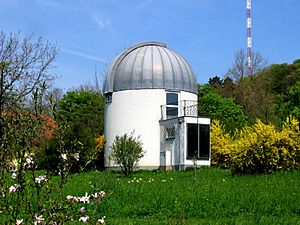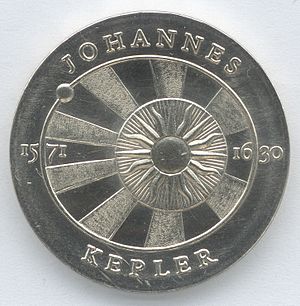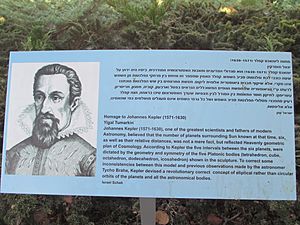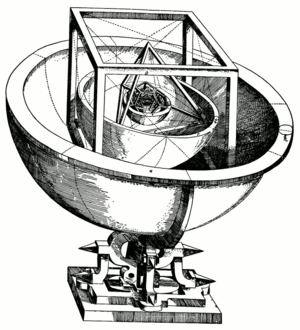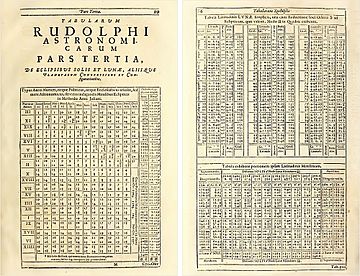Johannes Kepler facts for kids
Quick facts for kids
Johannes Kepler
|
|
|---|---|
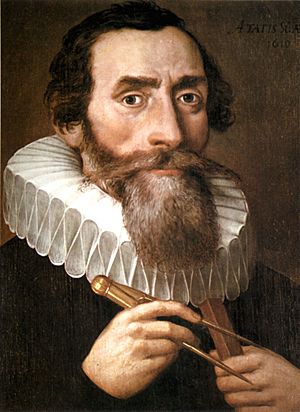
Portrait of Kepler by an unknown artist, 1610
|
|
| Born | December 27, 1571 |
| Died | November 15, 1630 (aged 58) Regensburg, Electorate of Bavaria, Holy Roman Empire
|
| Nationality | German |
| Alma mater | Tübinger Stift, University of Tübingen |
| Known for | Kepler's laws of planetary motion Kepler conjecture Rudolphine Tables |
| Scientific career | |
| Fields | Astronomy, astrology, mathematics and natural philosophy |
| Doctoral advisor | Michael Maestlin |
| Influences | Nicolaus Copernicus Tycho Brahe |
| Influenced | Sir Isaac Newton |
| Signature | |
Johannes Kepler (December 27, 1571 – November 15, 1630) was a German mathematician, astronomer, and astrologer.
Kepler is a key figure in the 17th-century scientific revolution. He is best known for his laws of planetary motion, based on his works Astronomia nova, Harmonices Mundi, and Epitome of Copernican Astronomy. These works also provided one of the foundations for Isaac Newton's theory of universal gravitation.
Contents
Early years
Kepler was born on December 27, the feast day of St John the Evangelist, 1571, in the Free Imperial City of Weil der Stadt (now part of the Stuttgart Region in the German state of Baden-Württemberg.
He was introduced to astronomy at an early age, and developed a love for it that would span his entire life. At age six, he observed the Great Comet of 1577, writing that he "was taken by [his] mother to a high place to look at it." In 1580, at age nine, he observed another astronomical event, a lunar eclipse, recording that he remembered being "called outdoors" to see it and that the moon "appeared quite red". However, childhood smallpox left him with weak vision and crippled hands, limiting his ability in the observational aspects of astronomy.
In 1589, after moving through grammar school, Latin school, and seminary at Maulbronn, Kepler attended Tübinger Stift at the University of Tübingen. There, he studied philosophy and theology, while he was a student, until he became Chancellor at Tübingen in 1590.
He proved himself to be a superb mathematician and earned a reputation as a skilful astrologer, casting horoscopes for fellow students. From 1583 to 1631, he learned both the Ptolemaic system and the Copernican system of planetary motion. He became a Copernican at that time. In a student disputation he maintained that the Sun was the principal source of motive power in the universe.
Despite his desire to become a minister, near the end of his studies, Kepler was recommended for a position as teacher of mathematics and astronomy at the Protestant school in Graz. He accepted the position in April 1594, at the age of 23.
Career
Working as a mathematics teacher at a seminary school in Graz, Kepler became an associate of Prince Hans Ulrich von Eggenberg. Later he became an assistant to the astronomer Tycho Brahe in Prague, and eventually the imperial mathematician to Emperor Rudolf II and his two successors.
Kepler's primary obligation as imperial mathematician was to provide astrological advice to the emperor. In addition to horoscopes for allies and foreign leaders, the emperor sought Kepler's advice in times of political trouble. Rudolf was actively interested in the work of many of his court scholars (including numerous alchemists) and kept up with Kepler's work in physical astronomy as well.
Court life brought Kepler into contact with other prominent scholars (Johannes Matthäus Wackher von Wackhenfels, Jost Bürgi, David Fabricius, Martin Bachazek, and Johannes Brengger, among others).
Kepler also taught mathematics in Linz, and was an adviser to General Wallenstein. Additionally, he did fundamental work in the field of optics, invented an improved version of the refracting telescope (the Keplerian telescope), and was mentioned in the telescopic discoveries of his contemporary Galileo Galilei. He was a corresponding member of the Accademia dei Lincei in Rome.
Kepler lived in an era when there was no clear distinction between astronomy and astrology, but there was a strong division between astronomy and physics. Kepler incorporated religious arguments and reasoning into his work, motivated by the religious conviction and belief that God had created the world according to an intelligible plan that is accessible through the natural light of reason. Kepler described his new astronomy as "celestial physics".
Kepler has acquired a popular image as an icon of scientific modernity and a man before his time; science popularizer Carl Sagan described him as "the first astrophysicist and the last scientific astrologer".
Personal life
In December 1595, Kepler was introduced to Barbara Müller, a 23-year-old widow (twice over) with a young daughter, Regina Lorenz, and he began courting her. Barbara and Johannes were married on 27 April 1597.
In the first years of their marriage, the Keplers had two children (Heinrich and Susanna), both of whom died in infancy. In 1602, they had a daughter (Susanna); in 1604, a son (Friedrich); and in 1607, another son (Ludwig).
Works
Mysterium Cosmographicum
Kepler's first major astronomical work, Mysterium Cosmographicum (The Cosmographic Mystery, 1596), was the first published defense of the Copernican system. In it, Kepler found a formula relating the size of each planet's orb to the length of its orbital period: from inner to outer planets, the ratio of increase in orbital period is twice the difference in orb radius. However, Kepler later rejected this formula, because it was not precise enough.
Kepler thought the Mysterium had revealed God's geometrical plan for the universe. Much of Kepler's enthusiasm for the Copernican system stemmed from his theological convictions about the connection between the physical and the spiritual.
In 1621, Kepler published an expanded second edition of Mysterium, half as long again as the first, detailing in footnotes the corrections and improvements he had achieved in the 25 years since its first publication. In terms of impact, the Mysterium can be seen as an important first step in modernizing the theory proposed by Copernicus in his De revolutionibus orbium coelestium.
Astronomia Nova
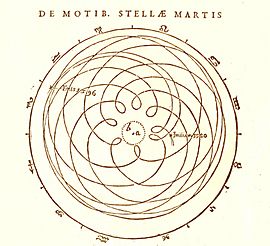
In this work Kepler introduced the revolutionary concept of planetary orbit, a path of a planet in space resulting from the action of physical causes. This idea was distinct from a previously held notion of planetary orb (a spherical shell to which planet is attached). As a result of this breakthrough astronomical phenomena came to be seen as being governed by physical laws.
In Kepler's religious view of the cosmos, the Sun (a symbol of God the Father) was the source of motive force in the Solar System. As a physical basis, Kepler drew by analogy on William Gilbert's theory of the magnetic soul of the Earth from De Magnete (1600) and on his own work on optics. Kepler supposed that the motive power (or motive species) radiated by the Sun weakens with distance, causing faster or slower motion as planets move closer or farther from it. He also created a formula in which a planet's rate of motion is inversely proportional to its distance from the Sun.
Kepler also formulated his first law of planetary motion that states all planets move in ellipses, with the Sun at one focus.
Epitome of Copernican Astronomy
The Epitome contained all three laws of planetary motion and attempted to explain heavenly motions through physical causes. Kepler contended that rotating massive bodies communicate their rotation to their satellites, so that the satellites are swept around the central body; thus the rotation of the Sun drives the revolutions of the planets and the rotation of the Earth drives the revolution of the Moon. In Kepler's era, no one had any evidence of Jupiter's rotation. However, Kepler argued that the force by which a central body causes its satellites to revolve around it, weakens with distance; consequently, satellites that are farther from the central body revolve slower.
Kepler completed the first of three volumes, consisting of Books I–III, by 1615 had them printed in 1617. However, the banning of Copernican books by the Catholic Church, as well as the start of the Thirty Years' War, meant that publication of the next two volumes would be delayed. The second volume, consisting of Book IV, was published in 1620, followed by the third volume, consisting of Books V–VII, in 1621.
Rudolphine Tables
In the years following the completion of Astronomia Nova, most of Kepler's research was focused on preparations for the Rudolphine Tables, which was completed in 1623. At the time it was considered his major work. However, due to the publishing requirements of the emperor and negotiations with Tycho Brahe's heir, it would not be printed until 1627.
Astronomiae Pars Optica

Through most of 1603, Kepler paused his other work to focus on optical theory; the resulting manuscript, presented to the emperor on 1 January 1604, was published as Astronomiae Pars Optica (The Optical Part of Astronomy). In it, Kepler described the inverse-square law governing the intensity of light, reflection by flat and curved mirrors, and principles of pinhole cameras, as well as the astronomical implications of optics such as parallax and the apparent sizes of heavenly bodies. He also extended his study of optics to the human eye, and is generally considered by neuroscientists to be the first to recognize that images are projected inverted and reversed by the eye's lens onto the retina. The solution to this dilemma was not of particular importance to Kepler as he did not see it as pertaining to optics, although he did suggest that the image was later corrected "in the hollows of the brain" due to the "activity of the Soul."
Today, Astronomiae Pars Optica is generally recognized as the foundation of modern optics (though the law of refraction is conspicuously absent).
Mathematics and physics

Kepler wrote the influential mathematical treatise Nova stereometria doliorum vinariorum in 1613, on measuring the volume of containers such as wine barrels, which was published in 1615. Kepler also contributed to the development of infinitesimal methods and numerical analysis, including iterative approximations, infinitesimals, and the early use of logarithms and transcendental equations. Kepler's work on calculating volumes of shapes, and on finding the optimal shape of a wine barrel, were significant steps toward the development of calculus.
Cultural influence and eponymy
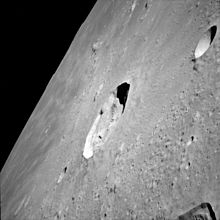
Kepler has acquired a popular image as an icon of scientific modernity and a man before his time; science popularizer Carl Sagan described him as "the first astrophysicist and the last scientific astrologer".
Directly named for Kepler's contribution to science are Kepler's laws of planetary motion; Kepler's Supernova SN 1604, which he observed and described; the Kepler–Poinsot polyhedra (a set of geometrical constructions), two of which were described by him; and the Kepler conjecture on sphere packing. Places and entities named in his honor include multiple city streets and squares, several educational institutions, an asteroid, and both a lunar and a Martian crater.
Writings by Kepler
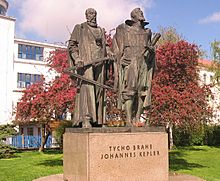
- Mysterium cosmographicum (The Sacred Mystery of the Cosmos) (1596)
- Astronomia nova (New Astronomy) (1609)
- Epitome astronomiae Copernicanae (Epitome of Copernican Astronomy) (published in three parts from 1618-1621)
- Harmonice Mundi (Harmony of the Worlds) (1619)
- Mysterium cosmographicum (The Sacred Mystery of the Cosmos) 2nd Edition (1621)
- Tabulae Rudolphinae (Rudolphine Tables) (1627)
- Somnium (The Dream) (1634)
Images for kids
-
Karlová street in Old Town, Prague – house where Kepler lived. Now a museum.
-
A statue of Kepler in Linz
-
The GDR stamp featuring Kepler
See also
 In Spanish: Johannes Kepler para niños
In Spanish: Johannes Kepler para niños


